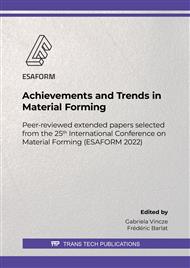p.1874
p.1882
p.1890
p.1900
p.1907
p.1914
p.1923
p.1931
p.1939
Measurement of Biaxial Deformation Behavior and Material Modeling for HI-PVC Using Multiaxial Tube Expansion Test
Abstract:
This study investigates the biaxial deformation behavior of the High Impact Polyvinyl Chloride (HI-PVC) used as a water pipe material. Multiaxial tube expansion test (MTET) was performed on the HI-PVC circular tube, and the stress-strain curves were measured for nine linear stress paths. The contours of plastic work and the directions of the plastic strain rates were also measurd. The experimental results show that the test sample has a strong anisotropy. Anisotropic hardening behavior was also confirmed from the evolution of the work contours. It was confirmed that the Yld2000-2d yield function had a better agreement with the measued work contour than Hill’s quadratic and the von Mises yield functons. Moreover, it was found that the test sample follows the normality rule with the Yld2000-2d yield function.
Info:
Periodical:
Pages:
1907-1913
Citation:
Online since:
July 2022
Authors:
Permissions:
Share:
Citation:


